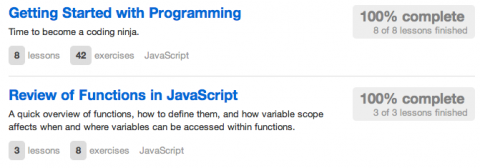Learning: Codecademy
 Codecademy’s Code Year, a program dedicated to teaching people Javascript over 2012. Unable to convince myseld people would follow through with this, I just dismissed the whole website. One friend even made the joke that resolutions like this are the 21st century version of signing up to the gym. However, once my cynicism faded, curiosity got the best of me and so I decided to see what they’ve accomplished. It’s been a while since I’ve done some programming, so getting a refresher seemed like a worthy adventure.
Codecademy’s Code Year, a program dedicated to teaching people Javascript over 2012. Unable to convince myseld people would follow through with this, I just dismissed the whole website. One friend even made the joke that resolutions like this are the 21st century version of signing up to the gym. However, once my cynicism faded, curiosity got the best of me and so I decided to see what they’ve accomplished. It’s been a while since I’ve done some programming, so getting a refresher seemed like a worthy adventure.
After spending a few days going through the existing lessons, a few compelling aspects of Codecademy really stood out:
- One Spot:Â There is no for context switching between book and screen or screen and other app. The lesson and the coding area are located next to each other, making it easier to follow the assignment and maintain focus.
- Development Environment:Â There is no environment to set-up, it’s self-contained. Yes, I know they use Javascript so this isn’t really a major issue, but once again though, having the coding area next to program output is an incredible time-saver.
- Q&A:Â Hints are embedded in each lesson and always a click away. If that doesn’t help, the Q&A community will help you work through most problems.
- Time:Â Each course has multiple sections, but they only require a few minutes each. Since your progress is saved, it’s simple to complete one quick lesson, go do something else, and come back later.
Codecademy is still a start-up and therefore still evolving. So while I’m going to be patient with them, there are a few areas could use some improvement:
- Lessons Quantity:Â There are just too few. This should rapidly increase in the near future, but right now, it’s a pain to get on a roll and then have to stopand wait for the next lesson set to be released.
- Cheat Sheets:Â It’s easy to forget something you’ve only done once. So after learning a new concept, a handy (possibly printable) cheat sheet containing basic structure or grammar would be more helpful than going back to reference an old lesson.
- Repetitive:Â There are areas where you constantly type in the same code over and over. While it does help drill home the point, it also can get annoying quickly.
- Errors:Â Programming errors, especially for newbies, bring everything to a halt. Sadly, most errors don’t say, “You should put a semicolon here,” or “You didn’t close out that function with a bracket.” A short lesson here and there on error messages and what they actually mean would go a long way.
- Curation:Â The Q&A is nice to have, but is going to be overwhelming as more people sign-up. People who post up questions are usually not clear in describing their problems, so its difficult to find the exact help you need. Given time, I hope they can curate or summarize some of the most common issues and the best answers.
Overall, I’m pleased with what I’ve seen. With the pieces they already have in place, it shouldn’t be too difficult to teach some fundamental programming concepts. As with any educational tool though, you get out what you put into it. There is no public resolution for Code Year needed to move forward, so get started and catch up with the rest of us. For a few minutes a day, it’s an easy investment to make.
Link:Â Codecademy
The Mobile Developer Journey
I have not abandoned this blog. I have in fact been helping a local company here with their product development. I’ll write further about them in the future, but for now, let’s just say I’m on what Vision Mobile would call the Mobile Developer Journey. The graphic summary of this journey was good enough for me to share. I wish they had spent a bit more time discussing the monetization challenges, but maybe that’s just my fault for not yet reading their report.
I’ll be back soon with more about my work. In the meantime, enjoy the pretty pictures.
The Real Customer
 I enjoyed reading Steve Johnson’s post on who the real customer is over on his Product Marketing blog. I’m not sure if Steve has a Telco background or not, but his comment regarding the person who uses your device being your customer, is spot on for this industry. The manufacturers who maintain direct contact with their end users tend to be the most successful. There are some who attempt to make their living catering to operator (distributor) wishes like LG and ZTE, but none ever seem to really garner significant mindshare.
I enjoyed reading Steve Johnson’s post on who the real customer is over on his Product Marketing blog. I’m not sure if Steve has a Telco background or not, but his comment regarding the person who uses your device being your customer, is spot on for this industry. The manufacturers who maintain direct contact with their end users tend to be the most successful. There are some who attempt to make their living catering to operator (distributor) wishes like LG and ZTE, but none ever seem to really garner significant mindshare.
Let’s review those that do.
Apple
I think we all know this story already. They are the poster child for making operators look like “dumb pipes”. Having completely flanked operators with their retail stores, music and app business, and line of personal devices, they’ve been able over the years to develop strong ties with their consumers. Globally, they’ve never been market share leaders, but those they served were passionate users. Their message rarely has been distorted by middle-men. What is the result? Operators bending over backwards to access that user base, breaking their internal rules and giving up revenue streams.
RIM/Blackberry
For years has been the de-facto choice for business users, offering services that other manufacturers either avoided or refused to compete on. So while they are struggling now, they built their success around “Crackberry” addicts. Operators couldn’t help but stock their products for fear of user revolts at their enterprise accounts. Even in the midst of their current troubles, the press and consumers still follow them without fail.
Google/Android
Obviously this story has not finished, but they do seem to be gaining traction at a rapid pace. Whether they continue to do that is still up for debate, however, their recent success is built once again on having a dedicated user base dependent on services that were not developed on the operator level. A “semi-open”approach versus the walled gardens that operators are famous for have served them well recently.
Nokia
I hesitate to put them here due to their recent issues with delivering a compelling smartphone. However, they still command close to 40% of the global market. And in markets with less operator control, Nokia is still the standard. Their broad portfolio, targeted to multiple income levels and consumer segments, still has them as a force to be recognized. While not obvious in the US, there are still Nokia fanatics in plenty of other countries.
Manufacturer success is never guaranteed, but there doesn’t seem to be any reason to believe that devotion to end-users will be any less successful in the future. It’s sad to think how many operators consider themselves the most important person in the value chain. Obviously they have their own roadmaps to manage, but more often than not, it appears as though they forget who they actually while frustrating their manufacturing partners in the process.
Will Mobile App Subscriptions Affect App Revenues?
I was reading a Wall Street Journal article last night about how the New Yorker is attempting to publish paid apps on Apple’s app store. In it’s current form, visitors to the store must download each issue separately, incurring a $4.95 charge each time. Obviously this will be annoying to many consumers, especially in this age of content delivery. As such, the New Yorker is pressuring Apple to create a subscription like feature. And at that point, a really weird thought popped into my head.
Would the introduction of subscription apps affect the ability for single-pay applications?
Give me a second, let me walk through my thinking:
- Consumer “Joe” is an active iPad user and spends about $10/month on applications, music, etc. He’s grown accustomed to seeing bills of this size from Apple.
- Joe now sees two of his favorite magazines are now offered via a subscription online for $4.95/month and decides to sign-up thinking, “This is great, more stuff for my iPad. And it’s such a great deal, as this is usually too expensive in print.”
- Now, his monthly spending at the iTunes store has doubled, making Joe worry he’s spending too much for this device. He now thinks he should cut back a bit.
- Not wanting to give up his magazines, Joe cuts back on other “silly” or “frivolous” games for his iPad, bringing his monthly spend back to it’s pre-subscription norm.
So I guess my question is this? Do users who fit under this or similar scenarios already unofficially pre-budget how much they’ll spend on downloads per month? And if so, will subscriptions quickly eat into the share of pocket that consumers like Joe would be willing to spend?
Obviously the content would have to be compelling enough, but subscription-based content has a long history and may seem “easy” for some consumers to quickly sign-up for on some platforms. Whether these subscriptions will make it just as easy to opt-out remains to be seen. If consumers get locked into long-term commitments like we see today in print versions, we might see an interesting blip on the radar of other application providers.


